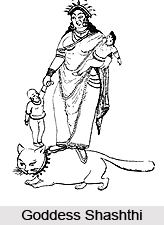 Goddess Shashthi is also worshipped as the deity of vegetation and reproduction. It is believed that she would bestow children as well as assist during childbirth. She is pictured as a maternal figure, riding a cat and nursing one or more infants beside. She is represented in a variety of forms. She is worshipped on the sixth day of each lunar month of the Hindu calendar and on the sixth day after birth of a child. Barren women and mothers to ensure the protection of their children worship Shashthi. She is mailnly worshipped in eastern India.
Goddess Shashthi is also worshipped as the deity of vegetation and reproduction. It is believed that she would bestow children as well as assist during childbirth. She is pictured as a maternal figure, riding a cat and nursing one or more infants beside. She is represented in a variety of forms. She is worshipped on the sixth day of each lunar month of the Hindu calendar and on the sixth day after birth of a child. Barren women and mothers to ensure the protection of their children worship Shashthi. She is mailnly worshipped in eastern India.
Shashthi is depicted as a motherly figure. Her complexion is depicted as yellow or golden. It is believed that devotee of Shashthi should meditate by reciting Dhyana mantra. A cat is the mount upon which she rides.
In the Kushan era she is depicted as two-armed and six-headed. Several coins, sculptures and inscriptions that were produced from 500 BCE to 1200 CE picture the six-headed Shashthi. She is shown surrounded by Skanda and Vishakha. The central head is surrounded by five female heads.
However the folk worship representation of Goddess Shashthi is a red-coloured stone that is placed beneath a banyan tree. These are found on the outskirts of villages. The banyan tree may be decorated with flowers or scattered with rice and other offerings. A Shalagrama stone, an earthen water pitcher, or a Purna Ghata set beneath a banyan tree are other common representations.
There is a ritual called Shashthi-kalpa which is performed on the sixth lunar day of every fortnight. She is continued to be worshipped on the sixth day of each of the twelve lunar months of the Hindu calendar as well as on the sixth day after childbirth in the lying-in chamber where the birth has taken place. She is worshipped in a different form in each of these months as the deities Chandan, Aranya, Kardama, Lunthana, Chapeti, Durga, Nadi, Mulaka, Anna, Sitala, Gorupini or Ashoka.
In North India she is worshipped during childbirth, puberty and during marriage rites. Women worship Shashthi on Ashoka Shashthi. They also observe Khas Shashthi in the month of Pausha. In Bengal and South India she is worshipped also on Aranva-Shashthi, the sixth day of the Hindu month of Jyestha. In Bengal, on the night of the sixth day after childbirth number of items may be placed in the lying-in chamber.
In Orissa, she is worshipped in the lying-in room on the sixth day and on the 21st day after childbirth as well as on every subsequent birthday of the child until he or she attains the age of sixteen.









